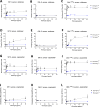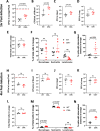Fibrin(ogen) engagement of S. aureus promotes the host antimicrobial response and suppression of microbe dissemination following peritoneal infection
- PMID: 35041705
- PMCID: PMC8797238
- DOI: 10.1371/journal.ppat.1010227
Fibrin(ogen) engagement of S. aureus promotes the host antimicrobial response and suppression of microbe dissemination following peritoneal infection
Abstract
The blood-clotting protein fibrin(ogen) plays a critical role in host defense against invading pathogens, particularly against peritoneal infection by the Gram-positive microbe Staphylococcus aureus. Here, we tested the hypothesis that direct binding between fibrin(ogen) and S. aureus is a component of the primary host antimicrobial response mechanism and prevention of secondary microbe dissemination from the peritoneal cavity. To establish a model system, we showed that fibrinogen isolated from FibγΔ5 mice, which express a mutant form lacking the final 5 amino acids of the fibrinogen γ chain (termed fibrinogenγΔ5), did not support S. aureus adherence when immobilized and clumping when in suspension. In contrast, purified wildtype fibrinogen supported robust adhesion and clumping that was largely dependent on S. aureus expression of the receptor clumping factor A (ClfA). Following peritoneal infection with S. aureus USA300, FibγΔ5 mice displayed worse survival compared to WT mice coupled to reduced bacterial killing within the peritoneal cavity and increased dissemination of the microbes into circulation and distant organs. The failure of acute bacterial killing, but not enhanced dissemination, was partially recapitulated by mice infected with S. aureus USA300 lacking ClfA. Fibrin polymer formation and coagulation transglutaminase Factor XIII each contributed to killing of the microbes within the peritoneal cavity, but only elimination of polymer formation enhanced systemic dissemination. Host macrophage depletion or selective elimination of the fibrin(ogen) β2-integrin binding motif both compromised local bacterial killing and enhanced S. aureus systemic dissemination, suggesting fibrin polymer formation in and of itself was not sufficient to retain S. aureus within the peritoneal cavity. Collectively, these findings suggest that following peritoneal infection, the binding of S. aureus to stabilized fibrin matrices promotes a local, macrophage-mediated antimicrobial response essential for prevention of microbe dissemination and downstream host mortality.
Conflict of interest statement
The authors have declared that no competing interests exist.
Figures







Similar articles
-
Host fibrinogen drives antimicrobial function in Staphylococcus aureus peritonitis through bacterial-mediated prothrombin activation.Proc Natl Acad Sci U S A. 2021 Jan 5;118(1):e2009837118. doi: 10.1073/pnas.2009837118. Epub 2020 Dec 21. Proc Natl Acad Sci U S A. 2021. PMID: 33443167 Free PMC article.
-
Genetic elimination of the binding motif on fibrinogen for the S. aureus virulence factor ClfA improves host survival in septicemia.Blood. 2013 Mar 7;121(10):1783-94. doi: 10.1182/blood-2012-09-453894. Epub 2013 Jan 8. Blood. 2013. PMID: 23299312 Free PMC article.
-
Mice expressing a mutant form of fibrinogen that cannot support fibrin formation exhibit compromised antimicrobial host defense.Blood. 2015 Oct 22;126(17):2047-58. doi: 10.1182/blood-2015-04-639849. Epub 2015 Jul 30. Blood. 2015. PMID: 26228483 Free PMC article.
-
Fibrinogen Is at the Interface of Host Defense and Pathogen Virulence in Staphylococcus aureus Infection.Semin Thromb Hemost. 2016 Jun;42(4):408-21. doi: 10.1055/s-0036-1579635. Epub 2016 Apr 7. Semin Thromb Hemost. 2016. PMID: 27056151 Free PMC article. Review.
-
Does fibrinogen serve the host or the microbe in Staphylococcus infection?Curr Opin Hematol. 2019 Sep;26(5):343-348. doi: 10.1097/MOH.0000000000000527. Curr Opin Hematol. 2019. PMID: 31348048 Review.
Cited by
-
Speckle fluctuations reveal dynamics of microparticles in fibrin scaffolds in a model of bacterial infection.NPJ Biol Phys Mech. 2025;2(1):15. doi: 10.1038/s44341-025-00019-1. Epub 2025 Jun 3. NPJ Biol Phys Mech. 2025. PMID: 40475318 Free PMC article.
-
Antibodies to coagulase of Staphylococcus aureus crossreact to Efb and reveal different binding of shared fibrinogen binding repeats.Front Immunol. 2023 Sep 27;14:1221108. doi: 10.3389/fimmu.2023.1221108. eCollection 2023. Front Immunol. 2023. PMID: 37828992 Free PMC article.
-
Fibrinogen γ' promotes host survival during Staphylococcus aureus septicemia in mice.J Thromb Haemost. 2023 Aug;21(8):2277-2290. doi: 10.1016/j.jtha.2023.03.019. Epub 2023 Mar 30. J Thromb Haemost. 2023. PMID: 37001817 Free PMC article.
-
Fibrinogen, Fibrin, and Fibrin Degradation Products in COVID-19.Curr Drug Targets. 2022;23(17):1593-1602. doi: 10.2174/1389450123666220826162900. Curr Drug Targets. 2022. PMID: 36029073 Free PMC article. Review.
-
Altered fibrinogen γ-chain cross-linking in mutant fibrinogen-γΔ5 mice drives acute liver injury.J Thromb Haemost. 2023 Aug;21(8):2175-2188. doi: 10.1016/j.jtha.2023.04.003. Epub 2023 Apr 14. J Thromb Haemost. 2023. PMID: 37062522 Free PMC article.
References
Publication types
MeSH terms
Substances
Grants and funding
LinkOut - more resources
Full Text Sources
Medical
Molecular Biology Databases

